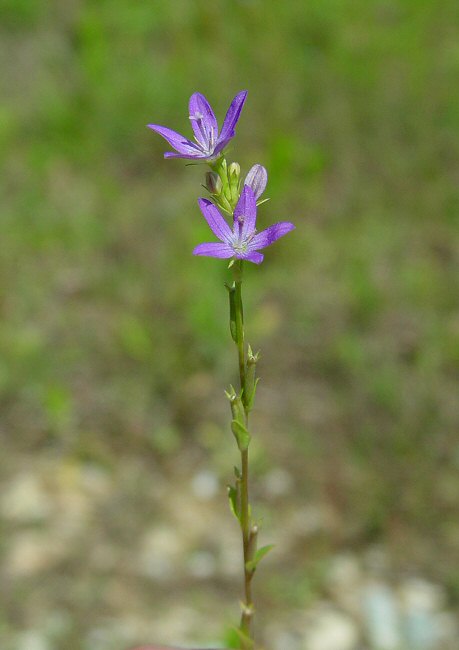Triodanis biflora (Ruiz & Pav.) Greene
Small Venus' Looking-Glass

Native
CC = 3
CW = 5
MOC = 36
© DETenaglia
Triodanis biflora (Ruiz & Pav.) GreeneSmall Venus' Looking-Glass | |
 |
Native CC = 3 CW = 5 MOC = 36 |
© DETenaglia |
|
Family - Campanulaceae Habit - Annual forb from a taproot. Sap milky. Stems - Variably ascending to erect, to 50 cm, sometimes multiple from the base, roughened with minute, recurved hairs along the angles, at least toward the base.
Leaves - Alternate, sessile. Stem leaves 5-20 mm long, 2-10 mm wide, gradually reduced upwards, 1.5-3.0 times as long as wide, elliptic to narrowly ovate, sessile but at most only slightly clasping the stem, mostly bluntly pointed at the tip, the margins finely scalloped or bluntly toothed to nearly entire, the upper surface glabrous or nearly so, the undersurface finely roughened or with relatively soft, inconspicuous hairs, mostly along the veins.
Inflorescences - Flowers 1-3 per node at most nodes of the stem, mostly cleistogamous, the normal open-flowering one(s) usually solitary (rarely 2 or 3) at the stem tip.
Flowers - Calyces with the tube 3-7 mm long, usually appearing slightly inflated. Chasmogamous flowers with 5 lobes, these 5-8 mm long, narrowly triangular to lanceolate. Cleistogamous flowers with 3-4 lobes, these 0.7-2.0 mm long, narrowly triangular. Corollas in normal flowers 5-lobed, purple to lavender, the lobes 5-9 mm long, 2-3 mm wide. Corolla tube 1.0-1.5 mm long. Stamens 5, alternating with the corolla lobes. Filaments translucent, expanded at the base, ciliate on the margins basally, to 1 mm broad at the base, thin and twisted in the apical 2/3, to 2 mm long. Anthers yellow, to 2 mm long, 0.4 mm broad, linear. Style 5 mm long, whitish basally, purple apically, with a few small hairs apically. Stigmas 3, spreading, 1 mm long. Ovary many-ovuled, 3-locular, placentation axile. Hypanthium (of chasmogamous flowers) green, to 1cm long, 2-3mm in diameter, glabrous.
Fruits - Fruits all similar in size and shape, straight and strongly ascending, 4.5-8.0 mm long, 1.2-2.0 mm wide, with (usually 3) oval to round pores 1.0-1.2 mm long located just beneath the sepals. Seeds brown, smooth, shiny, .5-.6mm long, ellisoid to orbicular, falling from pores.
Flowering - May - June. Habitat - Upland prairies, glades, ledges and tops of bluffs, forest openings, fens, pond margins, streambanks, fields, pastures, ditches, railroads, roadsides, and open, disturbed areas. Origin - Native to the U.S. Other info. - This little plant is often overlooked or ignored, partly because it is small and not very showy, and partly because it sometimes inhabits disturbed areas. Nevertheless, it is a distinctive member of our native flora. In Missouri it is mainly found in counties south of the Missouri River. Beyond Missouri it occurs throughout the southeastern quadrant of the continental U.S., and also numerous counties along the U.S. southern border and Pacific Coast. It is recognized by its sessile leaves along unbranched stems, and its purple flowers. An important character for identification of any species of Triodanis is the location and shape of the dehiscence pore. In T. biflora this is oval or round, and positioned at the top of the fruit, just beneath the sepal bases. The plant has the curious habit of forming mostly cleistogamous flowers (i.e., flowers which remain closed and are self-fertile). With age, the plant gets long and thin and the stems often recline on the ground. Photographs taken in off Lee Rd 54, Lee County, AL., 4-21-05 (DETenaglia); also at Coon Island Conservation Area, Butler County, MO, 5-19-2014, Otter Slough Conservation Area, Stoddard County, MO, 5-29-2020, and Tingler Prairie Natural Area, Howell County, MO, 6-10-2021 (SRTurner). |